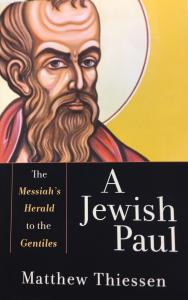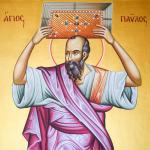We are back for a third and final segment of a three-part interview with Matthew Thiessen, author of the recent book, A Jewish Paul: The Messiah’s Herald to the Gentiles (Grand Rapids: Baker Academic, 2023). Dr. Thiessen is an associate professor of religious studies at McMaster University. He presents us with a well-written and provocative interpretation of Paul in this book.
If you missed the previous segments, click here for Part 1 and here for Part 2.
Part 3: Conclusion of the Interview with Matthew Thiessen

Oropeza
Your connection of “spirit”/pneuma with Abraham, Jesus, and gentiles is quite interesting. I’ve noticed, however, that Stoic philosophy is primarily used to support pneuma as a light material substance, whether fine particles, aether, or something else. It is held not only by you but also by Troels Engberg-Pedersen, Matt Novenson, and others. But Paul is Jewish, not Stoic. Maybe I overlooked it, or it’s in one of your other books, but are there Second Temple Jewish sources that support pneuma as a material substance?
Thiessen
Although Paul is Jewish this does not mean that he was uninfluenced by the philosophical and scientific currents of his day. Of course, he was no Stoic philosopher nor did he spend time writing scientific treatises on the ontological or metaphysical nature of pneuma. So, as is so often the case with Paul and other ancient writers, we have to fill in gaps from the literary remains of others. When Paul used pneuma, what would others have likely heard?
Oropeza
I’m glad you raise this question; salient interpretation should always be concerned with how Paul’s original auditors might have heard his letters.
Thiessen
Other Jewish writers were not also involved in scientific discussions either. The closest we get, and this is something that Engberg-Pedersen discusses, is the Wisdom of Solomon. This work is not straightforwardly Stoic in its thinking, but it does seem to contain stoicized elements, especially in relation to pneuma.
For instance, Wisdom speaks of the pneuma of the Lord filling the world and holding all things together (Wis 1:7) and then of divine wisdom in ways that evoke Stoic thinking about the pneuma: “wisdom is more mobile than any motion; because of her pureness she pervades and penetrates all things. For she is a breath of the power of God” (Wis 7:24–25).
In my own reading of Paul, I find it very suggestive that when he talks about the resurrected body, he speaks of it as a pneumatic body in the same context that he compares the resurrected body to astral bodies—sun, stars, and moon (1 Corinthians 15:35–49). To become a heavenly being and to enjoy the heavenly realm, one must become like the heavenly realm.
Here ancient scientists, following Aristotle, speak often of a fifth element of the cosmos, aether. Aetherial, heavenly bodies are material, but made of the best kind of matter—immortal, unchangeable, indestructible. Paul doesn’t use that language, but he uses the language of stars, and glory (doxa), and pneuma. And he uses the same language of the pneumatic bodies of the resurrection that ancient scientists do of aether.
Oropeza
Volker Rabens stresses the importance of the relational aspect regarding pneuma in Paul. What are your thoughts about the Holy Spirit as a personal being with which one has a relationship?
Thiessen
Rabens has written a lot on the topic of pneuma in ancient Judaism and Paul, and his work stresses the relational side of pneuma. This is an important aspect of Paul’s thought about the pneuma. This pneuma is not just any pneuma, not some sort of impersonal pneuma, but the pneuma of the Messiah, God’s son, and the pneuma of God who raised Jesus from the dead. That must always remain central to an account of pneuma.
Oropeza
I agree.
Thiessen
But I also balk a little bit at the language of relationship, perhaps because of modern connotations or limitations to the term that Rabens may not intend. When we speak of relationship, we naturally bring in notions of an external person—my relationships with my students or family. There are parallels here to how Paul thinks of one’s experience with the pneuma, but there are also dissimilarities.
For Paul, the pneuma is also something that inhabits a person and something in which a person dwells—believers are both in Christ and Christ is in believers through the presence of the pneuma. I fear the language of “relationship” does not capture the full extent of the participatory side of Paul’s pneumatic thought.
Oropeza
Regarding Christology, I concur with you regarding the pre-existence of Messiah, though I have argued that Christ was on rather than embodied in the “rock” in 1 Corinthians 10:4. I base this on gezerah shawah* and the use of “Lord” in Exodus 17:5–6 and Numbers 20:7–11 (Oropeza, 1 Corinthians, 127–28).
However, on Jesus’s resurrection, even though you rightly affirm it is a pneuma body (1 Corinthians 15:42–44), I tend to agree with James Ware** on the importance of the human aspect of Jesus’s resurrected body. There is an empty tomb in the Gospels, and Paul mentions that Jesus was “buried” before he “rose on the third day” (1 Cor 15:3–4). The notion of burial not only assumes that Jesus died but also that his body laid in a tomb and, given the resurrection, it vacated that tomb. For me, there is both continuity and discontinuity with regard to Jesus’s body at the resurrection and our own earthly bodies at the future resurrection.*** I’m not clear on what you think happened to the earthly body of Jesus. Could you elaborate?
Thiessen

While I don’t think Paul makes it entirely clear what he thinks happened with Jesus’s earthly body, I think we can draw out not only from 1 Corinthians 15:4, but also from 1 Cor 15:52 (“For the trumpet will sound, and the dead will be raised imperishable, and we will be changed”) that Paul thinks dead bodies come back to life at the resurrection. So, I have no problem taking 1 Cor 15:4 to imply that Jesus’s flesh-and-blood body was raised from the dead.
At the general resurrection, both those living and those dead will be transformed, though. Some people take this to mean that Paul envisages flesh-and-blood bodies being invested with an imperishable power that keeps their fleshly bodies from decomposing, aging, and dying. I, and others, have suggested that this view is right to believe that the resurrection entails embodiment.
But we think that statements like “flesh and blood cannot inherit the kingdom of God” and “nor does the perishable inherit the imperishable” (1 Cor 15:50) imply that Paul thinks the transformation that occurs in the resurrection is from a flesh-and-blood body to a body that consists of pneuma, and is therefore a body that is fit for a celestial habitat.
On my reading, Paul thinks that as resurrected humans ascend to the heavenly realm their raised flesh-and-blood bodies undergo transformation into entirely pneumatic bodies so that they can survive in their new environment. And so I think this is what he thinks happened to Jesus’s resurrected body—he became a life-giving pneuma (1 Cor 15:45). Both Jesus and those raised in him undergo a change where the heavier, coarser, and corruptible elements of the body are transformed into the entirely imperishable substance of pneuma.
Oropeza
I like that you emphasize the election of Israel as permanent and thus Israel’s hardening must be temporal in Romans 11. I would add that divine hardening is a form of divine punishment resulting from prior human disbelief, sin, or rebellion against God, just as in Romans 1:18–32, even when it also serves the further purpose of saving others (I discuss divine hardening, especially in Mark and Paul, in my Apostasy in the New Testament Communities series). Do you have any thoughts about how and/or when this hardening will end?
Thiessen
I find Paul’s statements toward the end of Romans 11 quite helpful here. There Paul claims that his readers, gentiles, were in the past disobedient but have now received mercy, while Israel has now become disobedient but that God in the future would have mercy on them too (Romans 11:31–32).
What this seems to imply is that Paul would have characterized Israel’s past behavior as generally obedient. Only now, at the coming of the Messiah, does Paul think Israel can be generally characterized as disobedient. And this disobedience, for Paul, is defined as apistia, a lack of faith or faithfulness that the Messiah’s coming surprisingly elicits (Romans 11:23).
In Romans 11 it sounds like God’s eschatological plan has taken a surprising detour—God has decided to bring gentiles into his eschatological deliverance, but in order to do this God needs to harden Israel temporarily. While Paul does not appear to get into specifics, he hopes that once the full number of gentiles comes in, many through Paul’s own work, then God would show mercy to Israel as well. And it sounds to me that Paul expected or hoped for this to come about in his own lifetime.
Oropeza
Thank you Matt, these interviews have been quite fascinating!****
Notes
* Gezerah Shawah is one of seven ancient interpretative principles attributed to Rabbi Hillel. This one involves “an analogy drawn between two verses in the Torah based upon a word they have in common.” See further on his and other midrash principles in Lori Baron and B. J. Oropeza, “Midrash,” in Exploring Intertextuality, eds. B. J. Oropeza and Steve Moyise (Eugene: Cascade, 2016), esp. 63–80 (quote on 66).
** James Ware, “Paul’s Understanding of the Resurrection in 1 Corinthians 15:36–54,” Journal of Biblical Literature 133 (2014) 809–835; also, James Ware, “The Resurrection of Jesus in the Pre-Pauline Formula of 1 Cor 15.3–5,” New Testament Studies 60 (2014) 475–98.
*** Some further ponderings of mine on resurrection related to dimension theory: hypothetically-speaking, as two-dimensional beings would not comprehend how a three-dimensional being who has the same properties of width and height as they do could move in and out of their space (since “depth” would be incomprehensible to them), so three-dimensional beings like ourselves cannot fully comprehend that a four-dimensional being can still have our same properties, but now with something new added (and of course, mortality taken away). Perhaps this analogy may help sharpen our imagination regarding continuity and discontinuity regarding resurrection bodies? (I learned a little bit about dimension theory from chemist, Dr. A. E. Wilder-Smith back in my Simon Greenleaf School of Law days.)
For my view of resurrection (though without discussing dimension theory), see, B. J. Oropeza, “Corinthian Diversity, Mythological Beliefs, and Bodily Immortality Related to the Resurrection (1 Corinthians 15),” in Scripture, Texts, and Tracings in Corinthians, eds. L. L. Belleville and B. J. Oropeza; Fortress Academic, 2019: 213–47.
**** To review Part 1 and Part 2 of this interview, click on the highlighted links towards the beginning of this page.


















